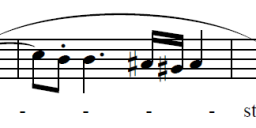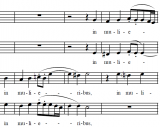Too much legato?
-
Ok I'm about to reveal myself as perhaps a total musical savage- but, here goes...more and more I'm being encouraged to play the organ in a legato manner. While I'm certainly capable of this I find it monotonous. The cantors seem to sing everything this way also. It seems to be the " correct sound" but sometimes it feels pretentious and soul killing, somewhat canned. Does anyone else feel this way?
-
Depends on the music. Something that's a bit more march like, needs a bit of what we used to call in the neo-Baroque days, "structured legato." Nonsense of course, since I am sure the Baroque composers fully understood legato. However, I understand the need for a slight bit of detachment for clarity. Depends on the voicing of your particular organ and the building acoustics.
Some pieces are legato and should be played and sung that way. But some monotony from it can really be a problem of accents not being, "accented."
It is hard to establish a beat on the organ. I have, at times, created the illusion of a beat by holding the pedal note of the first chord in the measure a tiny bit longer than succeeding notes. It does simulate to some degree an "accent" on the first beat of the measure. -
You hear a sales pitch for a car and it's so smooth it doesn't seem credible- the sales person is trying to com you, they're simply not sincere- well, too much super smooth delivery in church rubs me that way also. Seems insincere somehow...Thanked by 1CHGiffen
-
Never thought of that. But I don't expect to find a "sincere" church or music program any more than I expect to find the sincere pumpkin patch Linus looks for every year to attract the Great Pumpkin. LOL.
But I will say that you have to work with the building and the organ. They are all different in every place I have been. A good thing to do once in a while, is have someone else play the organ while you move around the building and actually listen to what the congregation hears. It can be both revealing and surprising. For example, I found that the organ volume drops significantly about a third of the way from the front, where those side arms are in our cross-shaped building. Didn't know that.Thanked by 1Matilda -
Seconding Charles: depends on what music you're playing. Cannot imagine using staccato, however.Thanked by 1Matilda
-
My current job has me playing two very different organs- your advice is great, also because what sound good with one does not work so well with the other. One is an old tracker that's pretty stiff and it's hard to get a smooth sound , I practically have to press my forearms on it. The other is a 50 year old electropneumatic. It's a lot of fun but confusing.
-
How one plays (or has to play) a hymn which has several repeated notes in a row (such as LAUDA ANIMA ("Praise, my soul, the King of heaven") reveals a lot about room acoustics, legato(ish) playing versus a certain amount of detachment in playing. On the other hand, playing a hymn or tune that is more melismatic (several different notes on some syllables) reveals something different about legato playing that reinforces proper phrasing ... think of the "Alleluia" at the end of each phrase of "Jesus Christ is ris'n today", or, say, my own GLOUCESTER CRESCENT ("Sing for the morning's joy, Cecilia, sing").

 Giffen-Sing_for_the_mornings_joy.pdf88K
Giffen-Sing_for_the_mornings_joy.pdf88K -
Cannot imagine using staccato, however.
Purely from a singing perspective, staccato markings - like marcato and legato - have their place. As pointed out above, it depends on circumstances. Here are some examples from the Ave Maria (Victoria / Handl)...

 Example 1 - Ave Maria.PNG406 x 162 - 5K
Example 1 - Ave Maria.PNG406 x 162 - 5K
 Example 2 - Ave Maria.PNG714 x 571 - 24K
Example 2 - Ave Maria.PNG714 x 571 - 24K -
For the Sanctus of one Ordinary we used, I asked our organist to use non-legato technique for the pedal part. That drew the sonic picture of the ranks and ranks of angels singing "Holy, Holy.....". It also had the benefit of a clearer demarcation of the tempo. There are times and places, yup.
-
Well another thing I've noticed is that with less legato playing i do get " clearer demarcation of tempo" and people seem to sing better - they can follow more easily, though perhaps the sound is a bit cruder. When the sound blends like syrup the ordinary folks get lost. Is there perhaps an ideal hymn playing technique, something between " glue" and " chop"?
-
I have encountered two distinct 'schools' of hymn playing. One maintains that repeating tones in all voices must always be detached a la Dupre etc. (generally given half their notated value), the reasoning being that this helps provide rhythmic clarity. The other school maintains that repeating tones in the lower voices should always be tied, with the justification that the ensuing legato helps promote healthy legato singing. I personally think it is helpful to be able to employ both techniques, and to combine the concepts depending on musical context.
-
Matilda, as others have hinted at, I think a lot of the answer depends on the acoustic properties of your building. My (carpeted) church has fairly minimal reverberation, and the organ is comparatively close to the congregation...so when playing hymns and accompanying the choir I generally aim for a "medium-legato" touch, as it were. But I occasionally fill in at a much larger church with no carpeting, where the organ is in a loft high above people's heads. If I were to use the same touch in that room, everything would sound like mush, so I have to adopt a more staccato style of playing if there's any hope of making the music intelligible.Thanked by 1Matilda
-
I agree with MarkS. I was taught the "repeating tones in all voices must always be detached a la Dupre" technique, but I never obeyed that directive as much as my teacher would have liked. I find it to be fussy, and I think it makes SATB hymnody unnecessarily difficult to play. I use the "Irishtenor Technique," wherein I do whatever I think is necessary in the moment. More detached notes/separation if I'm in an unfamiliar space or leading a congregation at a church where I don't play often. More legato if the people are used to me and if the space/acoustic allows for it.Thanked by 1Matilda
-
Thanks you guys! It sounds like there are many ways to look at this. As usual, this is a great way to get some personal sticky points aired and gives access to levels of expertise that are usually out of my range!Thanked by 1CHGiffen
Welcome to the MusicaSacra Forum!
To participate in the discussions on Catholic church music, sign in or register as a forum member, The forum is a project of the Church Music Association of America.
Categories
- All Discussions21,111
- General Music Discussion8,219
- Job Openings197
- Management of Music Programs850
- Choral Matters533
- Church Documents and Rubrics524
- CMAA Notes302
- Events716
- For Newcomers: Read First26
- Sacred Polyphony546
- Hymnody872
- Gregorian Chant: General2,698
- ↳ Graduale Romanum and Liber Usualis368
- ↳ Graduale Simplex60
- ↳ Semiology63
- Vernacular Plainsong696
- Anglican Use and Anglican Chant68
- Organ, Other Instruments and Repertoire435
- New Composition/Works in Progress1,291
- Recordings232
- Music for Hispanic Ministry159
- Music Education: Children211
- Music Education: General222
- News Items245
- Positions Wanted2
- General Discussion: Catholicism739
- Amusements177
- General Discussion1,034
- Opinions117


